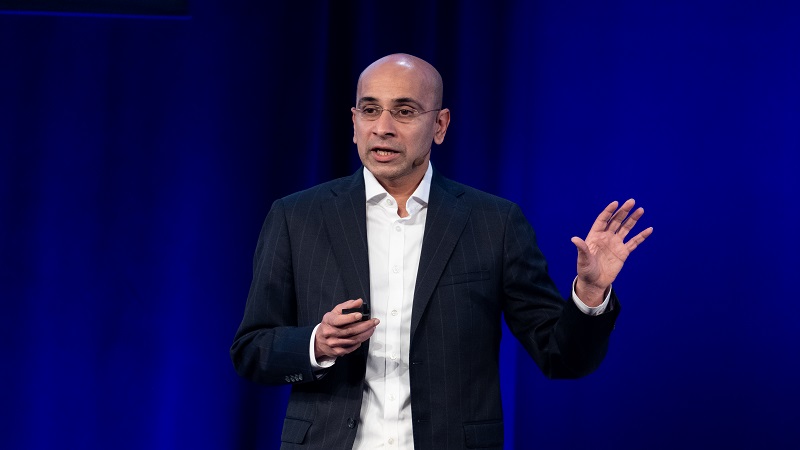 CLOUD
CLOUD
 CLOUD
CLOUD
 CLOUD
CLOUD
With more than 300,000 employees and operations in more than 100 countries, JPMorgan Chase & Co. is a vast and complex organization. But that hasn’t stopped the world’s largest bank from implementing an ambitious strategy to move most of its operations to the cloud.
JPMorgan Chase isn’t inclined to shy away from big technology investments. The company will spend a stunning $17 billion on information technology this year and expects to migrate 70% of its more than 6,000 applications to its public and private cloud.
Arvind Joshi (pictured) is driving much of that program. As chief financial officer and chief operating officer for global technology, he takes a methodical, application-by-application approach that recognizes cloud computing isn’t a one-size-fits-all solution.
“It’s application by application. It’s workload placement by workload placement,” he said in an interview with SiliconANGLE. “The decision-making framework for how you move your applications is nuanced across at least half a dozen factors.”
JPMC’s hybrid cloud architecture currently spans 32 global data centers and all three major public clouds. Through modernization, the company plans to reduce its data center portfolio to about 17 highly automated facilities using cloud-native constructs with able to shift workloads fluidly into the public cloud.
“Our strategic data centers in North America are very modern, very high-density and low-power with cloud-native infrastructure that allows us to scale or burst applications when we want rather than having to reserve fixed amounts of cloud computing capacity,” he said. Modernized applications avoid the need for workarounds such as spot instances by scouring the cloud ecosystem for surplus capacity and using it as needed.
Reducing costs is part of the objective – and JPMC believes it can realize up to 30% efficiency gains with its hybrid cloud – but the nuanced nature of its business demands that decisions be made on a case-by-case basis.
Joshi said his overarching objective isn’t to cut costs so much as to reduce the time-to-release cycles for products and features. In some cases, cost savings are secondary.
“There could be certain applications where resiliency and data sensitivity are the primary factors,” he said. “For some, it’s low latency at any cost. In those scenarios, I’m not thinking about optimizing for cost but literally for microsecond data exchange.”
One critical decision is whether to anchor applications in the public or private cloud. “Certain applications just make sense to go directly into the public cloud, such as those that are customer-facing, need faster time to market and have less data sensitivity,” he said. Other workloads, like some on the trading side of the business, need very low latency. You want the data and applications as close as possible.”
The multi-cloud strategy encompassing three hyperscalers keeps JPMC’s options open for where to host workloads. “We want to avoid any lock-in or concentration risk,” Joshi said. “The strategy gives us enough optionality as we become more dependent on the cloud.”
Measuring success is more complicated than just computing savings on storage and processing. Joshi’s group has embraced DevFinOps, a combination of development, finance and operations that integrates financial management into the development and operations lifecycle. It extends the principles of DevOps to ensure that cost considerations are included in every phase of software development and operations.
“We spend $17 billion on technology and a significant part of that is investment,” he said. “As you invest in infrastructure, you improve the productivity of software engineers.” Developer agility and application performance are at least as important as lower infrastructure costs.
Like most IT executives, Joshi has been keeping an eye on the burgeoning generative artificial intelligence field but he sees no reason to overspend on new applications immediately. “Machine learning has been around for a number of years, and we already have five or six hundred AI applications in production,” he said, citing mission-critical use cases like fraud detection and risk mitigation. “We’re seeing a lot of demand signals [for generative AI], but how much of that converts into commercially viable use cases is questionable. It’s early and considerable work is happening.”
More important is the corporation’s three-stage goal to move data to the cloud, consolidate high-quality data into a single data lake, and create a data-centric culture throughout the organization. “The industry shift in financial services means we need to ask everyone to think differently about data and think about data and treated as a competitive advantage,” he said.
Joshi’s pragmatic approach reflects his somewhat unconventional background for an IT leader. He has never held a formal IT title, having worked in financial and strategy roles at JPMC, PricewaterhouseCoopers International Ltd. and other financial institutions.
Prior to taking on the global technology role, he was CFO of investment, corporate banking and wholesale payments operations for the corporate and investment bank. That job had a significant technology component, paving the way for him to later take on the chief operating officer role for the public cloud program.
“In my CFO role I want to extract as much value as I can from $17 billion we invest, but a lot of that $17 billion is in multiyear programs such as cloud and the data center exit,” he said. “The ability to drive as much efficiency from the $17 billion is directly related to the ability to execute these multiyear programs. That’s where the link is between my CFO and COO roles.”
Support our mission to keep content open and free by engaging with theCUBE community. Join theCUBE’s Alumni Trust Network, where technology leaders connect, share intelligence and create opportunities.
Founded by tech visionaries John Furrier and Dave Vellante, SiliconANGLE Media has built a dynamic ecosystem of industry-leading digital media brands that reach 15+ million elite tech professionals. Our new proprietary theCUBE AI Video Cloud is breaking ground in audience interaction, leveraging theCUBEai.com neural network to help technology companies make data-driven decisions and stay at the forefront of industry conversations.